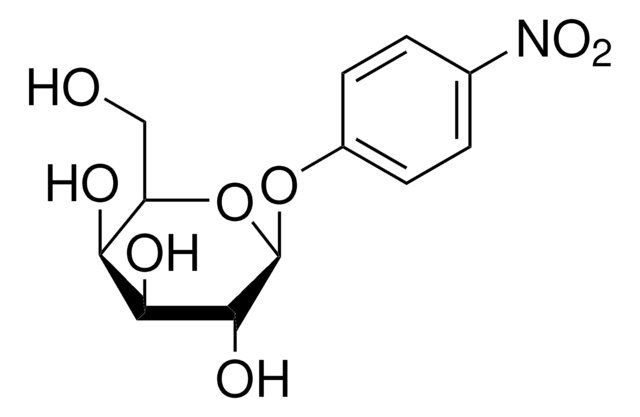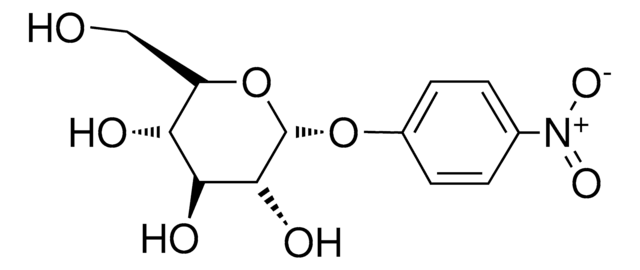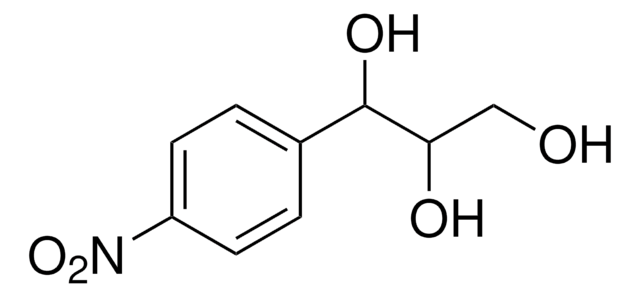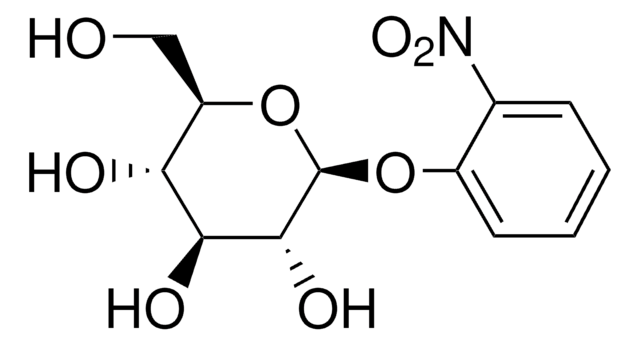Transportation information can be found in Section 14 of the product's (M)SDS.To access the shipping information for this material, use the link on the product detail page for the product.
N1377
4-Nitrophenyl α-D-glucopyranoside
chromogenic, ≥99%, powder or crystals
Synonym(s):
p-Nitrophenyl α-D-glucopyranoside
About This Item
Recommended Products
Product Name
4-Nitrophenyl α-D-glucopyranoside, ≥99%
Quality Level
Assay
≥99%
form
powder or crystals
solubility
methanol: 20 mg/mL, clear to very slightly hazy, colorless to greenish-yellow
storage temp.
−20°C
SMILES string
OC[C@H]1O[C@H](Oc2ccc(cc2)[N+]([O-])=O)[C@H](O)[C@@H](O)[C@@H]1O
InChI
1S/C12H15NO8/c14-5-8-9(15)10(16)11(17)12(21-8)20-7-3-1-6(2-4-7)13(18)19/h1-4,8-12,14-17H,5H2/t8-,9-,10+,11-,12+/m1/s1
InChI key
IFBHRQDFSNCLOZ-ZIQFBCGOSA-N
Looking for similar products? Visit Product Comparison Guide
Storage Class Code
11 - Combustible Solids
WGK
WGK 3
Flash Point(F)
Not applicable
Flash Point(C)
Not applicable
Personal Protective Equipment
Choose from one of the most recent versions:
Already Own This Product?
Find documentation for the products that you have recently purchased in the Document Library.
Customers Also Viewed
Articles
Probiotics exhibit an inhibitory effect on pathogens, help prevent chronic intestinal inflammatory diseases or atopic syndromes, and support the immune system.
Probiotics exhibit an inhibitory effect on pathogens, help prevent chronic intestinal inflammatory diseases or atopic syndromes, and support the immune system.
Probiotics exhibit an inhibitory effect on pathogens, help prevent chronic intestinal inflammatory diseases or atopic syndromes, and support the immune system.
Probiotics exhibit an inhibitory effect on pathogens, help prevent chronic intestinal inflammatory diseases or atopic syndromes, and support the immune system.
-
What is the Department of Transportation shipping information for this product?
1 answer-
Helpful?
-
-
What is the solubility of 4-Nitrophenyl α-D-glucopyranoside, Product N1377?
1 answer-
We test the solubility of 4-Nitrophenyl α-D-glucopyranoside at 20 mg/mL in methanol. When 4-Nitrophenyl α-D-glucopyranoside is used as a substrate for α-glucosidase, a 4 mM stock solution is made in water.
Helpful?
-
-
What is the melting point and specific rotation for 4-Nitrophenyl α-D-glucopyranoside, Product N1377?
1 answer-
The melting point range from our MSDS is 209-213 °C. The optical rotation is lot specific, and can be found on the Certificate of Analysis at our website.
Helpful?
-
-
How is 4-Nitrophenyl α-D-glucopyranoside, Product N1377, used?
1 answer-
4-Nitrophenyl α-D-glucopyranoside is used as a substrate for the assay of α-glucosidase. A stock solution of 4 mM is prepared in deionized water. Upon the enzymatic hydrolysis of this substrate, 4-nitrophenol is produced. The molar extinction coefficient of 4-nitrophenol in 0.01 M NaOH (pH 10.2) is approximately 18,380 at 400 nm.
Helpful?
-
Active Filters
Our team of scientists has experience in all areas of research including Life Science, Material Science, Chemical Synthesis, Chromatography, Analytical and many others.
Contact Technical Service














